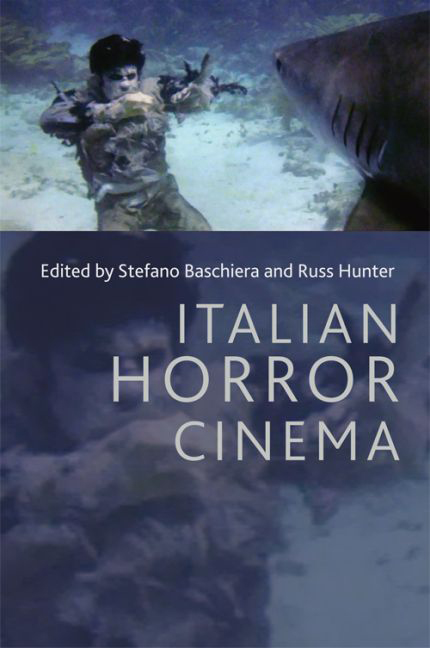Book contents
- Frontmatter
- Contents
- List of figures
- List of contributors
- Acknowledgements
- Introduction
- 1 Preferisco l'inferno: early Italian horror cinema
- 2 Domestic films made for export: modes of production of the 1960s Italian horror film
- 3 The 1980s Italian horror cinema of imitation: the good, the ugly and the sequel
- 4 Knowing the unknown beyond: ‘Italianate’ and ‘Italian’ horror cinema in the twenty-first century
- 5 Bavaesque: the making of Mario Bava as Italian horror auteur
- 6 The Argento Syndrome: aesthetics of horror
- 7 Scrap metal, stains, clogged drains: Argento's refuse and its refusals
- 8 The giallo /slasher landscape: Ecologia del delitto, Friday the 13th and subtractive spectatorship
- 9 Kings of terror, geniuses of crime: giallo cinema and fumetti neri
- 10 Political memory in the Italian hinterland: locating the ‘rural giallo’
- 11 The horror of progressive rock: Goblin and horror soundtracks
- 12 ‘The only monsters here are the filmmakers’: animal cruelty and death in Italian cannibal films
- 13 Italian horror cinema and Italian film journals of the 1970s
- Index
Introduction
Published online by Cambridge University Press: 12 September 2017
- Frontmatter
- Contents
- List of figures
- List of contributors
- Acknowledgements
- Introduction
- 1 Preferisco l'inferno: early Italian horror cinema
- 2 Domestic films made for export: modes of production of the 1960s Italian horror film
- 3 The 1980s Italian horror cinema of imitation: the good, the ugly and the sequel
- 4 Knowing the unknown beyond: ‘Italianate’ and ‘Italian’ horror cinema in the twenty-first century
- 5 Bavaesque: the making of Mario Bava as Italian horror auteur
- 6 The Argento Syndrome: aesthetics of horror
- 7 Scrap metal, stains, clogged drains: Argento's refuse and its refusals
- 8 The giallo /slasher landscape: Ecologia del delitto, Friday the 13th and subtractive spectatorship
- 9 Kings of terror, geniuses of crime: giallo cinema and fumetti neri
- 10 Political memory in the Italian hinterland: locating the ‘rural giallo’
- 11 The horror of progressive rock: Goblin and horror soundtracks
- 12 ‘The only monsters here are the filmmakers’: animal cruelty and death in Italian cannibal films
- 13 Italian horror cinema and Italian film journals of the 1970s
- Index
Summary
THE UNEXPECTED CONTEXTS OF ITALIAN HORROR CINEMA
When the esteemed English actor David Hemmings passed away at the end of 2003 his obituary quickly appeared in numerous newspapers. Naturally his long and varied career was widely celebrated. Few newspapers, however, gave much attention to his starring role in Italian horror film director Dario Argento's Profondo rosso /Deep Red (1975). One of the few exceptions here was The Guardian, which rather enigmatically noted that Hemmings sometimes turned up in ‘unexpected contexts’ (Pulleine, 2003). Over the course of its history from the late 1950s until at least the early 1980s, Italian horror was unique enough, strange enough and distinctive enough to be considered an ‘unusual context’. The nature of Italian horror films varied greatly depending upon the director involved and the budget available. But a typical Italian horror might ‘star’ a partly or mildly well-known British or American actor, be directed by an Italian using an Anglo-Saxon pseudonym operating on a low budget, ape at least some of the central features of a previously successful film (perhaps copying the formula of its title), contain a large smattering of gore, and nudity, be scored with a pulsating (possibly synth-based) soundtrack and receive little or no critical praise.
In many ways Profondo rosso was atypical, as Dario Argento had access to higher budgets than his contemporaries, better distribution channels and was arguably the first Italian horror director with ‘auteur’ ambitions. Instead, most Italian horror directors, working with low budgets and constricted schedules, were viewed more as popular cinema specialists rather than formally esteemed craftsmen. Regardless, David Hemmings’ appearance in one of the most iconic of all Italian horror films was not really all that unexpected, at least not within the context of how Italian horror cinema functioned as a whole. The dynamics of how such films were conceived, produced, marketed and exhibited are exemplary of the way Italian low-budget genre production of the time worked. However, it is precisely these features that mean Italian horror cinema has, for most of its history, been viewed as a particularly lowbrow manifestation of genre cinema. As Leon Hunt (2000: 326) has noted, there is a long-standing orthodoxy among critics of the horror film that suggests ‘“good” horror movies do not show much actual horror (Universal, Lewton, Tourneur), but “bad” ones do (Hammer, the Italians) because they lack imagination, taste and restraint’.
- Type
- Chapter
- Information
- Italian Horror Cinema , pp. 1 - 14Publisher: Edinburgh University PressPrint publication year: 2016



